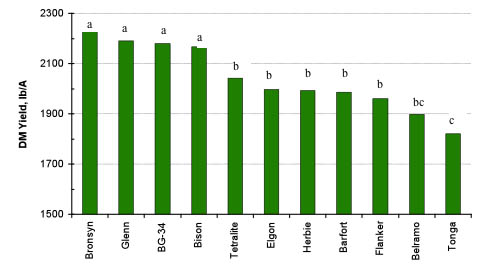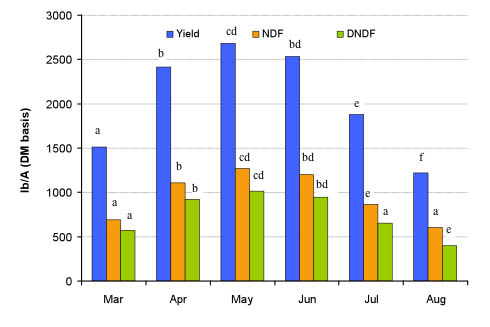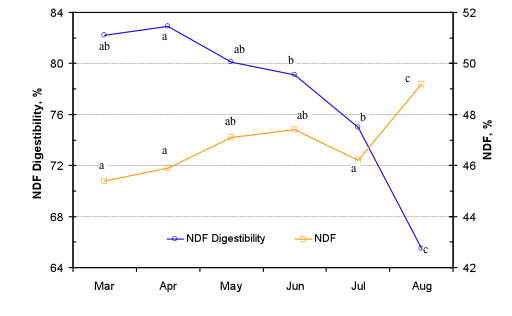 |
April 2009
|
April 2009 // Volume 47 // Number 2 // Research In Brief // v47-2rb8
Improved Understanding of Fiber Digestibility in Ryegrasses
Abstract
Dairy nutritionists have long known that forages with the same laboratory analysis could produce significantly different performance in lactating cows. Neutral detergent fiber digestibility (NDFD) may explain much of this variation. The objectives of the study described here were to demonstrate NDFD variation between varieties of ryegrass and season of harvest and to use this information as the basis for an educational Extension program. Large differences in NDFD were found among 11 varieties of ryegrass. This information was used to change the way livestock rations are balanced and it is hoped will convince grass seeds companies to focus more on fiber digestibility.
Introduction
Plant fiber has three major components: cellulose, hemicellulose, and lignin. Cellulose and hemicellulose are digestible to some extent by ruminants. Ruminants can convert these fiber components to energy because the rumen provides the correct environment for bacteria and other microorganisms to break down the fiber. Lignin is indigestible and thus cannot be used by ruminants for energy.
Most of the energy a cow receives in her diet comes from carbohydrates, which are a combination of non-fiber carbohydrates (grains) and fiber carbohydrates. As the digestibility of the fiber fraction increases, the total net energy of the forage increases, as does total feed intake (Nocek & Russell, 1988; Titel, 2000). Increasing neutral detergent fiber digestibility (NDFD) by one percentage point resulted in a 0.37 lb increase in dry matter intake and boosted fat-corrected milk production by 0.55 pounds (Oba & Allen, 1999a).
Several factors can affect forage's NDFD, including the amount of lignin, hybrid or variety, soil fertility, weather conditions, and forage harvest and storage practices (Oba & Allen, 1999a; Casler & Jung, 2006; Jung, 1989). In the past few years, several researchers have looked closely at NDFD in corn and alfalfa, particularly the variation among varieties (Beckman & Weiss, 2005; Oba & Allen, 1999b). However, limited research has been done regarding the variation in NDFD of cool-season grasses.
In one study in the Midwest, the average NDFD of grass hay/silage samples submitted for fiber digestibility analysis was 53%, while individual samples ranged from 36 to 74% (Hoffman, 2003). For a typical dairy ration, this variation could result in a 5 lb per cow per day difference in milk production. Similar production responses and variation would be expected in growing sheep and cattle as well.
Dairy producers and dairy nutritionists have known for years that forages with the exact same laboratory analysis could have significantly different performance in lactating cows. In the past few years, research has shown that the digestibility of neutral detergent fiber (NDF) may explain much of this variation. However, in Oregon very few nutritionist or dairymen have been accounting for fiber digestibility in grass while balancing rations. Part of the resistance for change has been the lack of understanding on the large variations seen in grasses compared to corn or alfalfa. This project was designed to highlight the large variation in the NDFD of grasses and persuade producers and nutritionist to change the way they balance rations.
Objectives
The objectives of the project described here were to:
- Determine fiber content and the variation in digestibility of eleven common ryegrasses,
- Evaluate variation by cutting,
- Determine annual energy differences due to NDFD differences, and
- Use the information as part of an educational Extension program aimed at both livestock producers and the grass seed industry.
Procedures
Eleven ryegrasses commonly grown in Oregon were selected and planted in September 2004 in Tillamook, Oregon. Plots were 5' x 20', replicated three times, and all planted at the same time. Plots were fertilized annually using four separate applications of nitrogen annually of approximately 75 lbs/acre/year or 300 lbs.
For 2 years, the plots were mechanically harvested six times per year at approximately 28-day intervals beginning in March and continuing through August. Yield data was recorded and samples were taken and dried in a 550C forced-air oven for 48 hour and analyzed for DM content. All samples were ground with a Wiley Mill (1mm screen; Arthur H. Thomas, Philadelphia, PA). Samples were analyzed for neutral detergent fiber (NDF) and NDFD (VonSoest et al., 1991). Fiber digestibility was determined in our lab using a Daisy II Incubator (Ankom Technology, Macedon, NY).
Digestibility and yield data were analyzed and developed into an educational Extension program that was conducted across the state in two statewide workshops and six regional programs. Information was included in newsletters going to producers, nutritionists, and the grass seed industry and was presented at the Pacific Northwest Nutrition Conference. Data were analyzed as a completely randomized design with the MIXED procedure of SAS (SAS Institute, Cary, NC).
Results
Total dry matter ranged from 5.8 tons to 6.5 tons per acre. Bronsyn was the highest yielding ryegrass both years, and Tonga was the lowest producing variety both years (Figure 1). Figure 2 illustrates the NDF digestibility of each variety over the 2 years studied. Data indicated there was around a 10% difference between the highest variety Elgon and the lowest variety (Flanker). If you compare Figure 1 to Figure 2, you will notice some varieties that yielded high in total dry matter, like Bronsyn, had some of the lowest fiber digestibility values.
Figure 3 shows the total pounds of digestible fiber harvested annually by variety. This value is generated by multiplying the yield times the percentage of digestible fiber. This analysis showed a 32% variation in digestible fiber per acre from the highest variety of ryegrass (Elgon) to the lowest variety (Tonga). Figure 4 shows change in yield of dry matter, neutral detergent fiber (NDF) and digestible neutral detergent fiber digestibility (DNDF) from March to August. While there was some variation from year to year, most varieties were very consistent from one year to another.
One major goal of the project was to understand seasonal changes in fiber and fiber digestibility. Figure 5 illustrates NDF and NDFD values by cutting. Neutral detergent fiber values averaged 45% of the total dry matter in March, but ended up at 51% by August. Conversely, NDFD was at 83% in March and declined to around 65% by August.
Figure 1.
Dry Matter Yield of 11 Perennial Ryegrasses. Means Different Superscripts Differ (P < 0.05).
Figure 2.
Neutral Detergent Fiber Digestibility (NDFD) of 11 Perennial Ryegrasses. Means Different Superscripts Differ (P < 0.05).
Figure 3.
Digestible Neutral Detergent Fiber (DNDF) Yield of 11 Perennial Ryegrasses. Means Different Superscripts Differ (P < 0.05).
Figure 4.
Change in Yield of Dry Matter, Neutral Detergent Fiber (NDF), and Digestible Neutral Detergent Fiber Digestibility (DNDF) from March to August. Means Within a Line with Different Superscripts Differ (P < 0.05).

Figure 5.
Change in Neutral Detergent Fiber (NDF) and Neutral Detergent Fiber Digestibility (NDFD) from March to August. Means Within a Line with Different Subscripts Differ (P < 0.05).
Summary
Before this project, very little attention was given to the variability seen between grass varieties or the season they were harvested. This project has helped emphasize the importance of using feed analysis instead of book values for digestibility.
As we continue to learn more about NDFD in grasses, it becomes apparent there are significant variations that have large financial impacts on producers and alter animal performance. The difference seen from the best ryegrass to the worst is significant for several reasons. First, a 10% increase in digestible fiber means there is more energy available in the rumen for microbial growth and ultimately for milk production and/or animal performance. This increased energy actually increases nitrogen efficiency allowing the rumen to make better utilization of the nitrogen in the forage. Better nitrogen utilization reduces losses in the form of ammonia gas and excretions in the urine.
Differences observed in total digestible fiber harvested per acre (32%) has significant impacts on farm productivity. It is estimated that the amount of extra energy produced from digestible fiber advantage of the ryegrass with the highest NDFD compared to the ryegrass with the lowest (NDFD) is enough to produce an extra 28 cwt of milk per acre per year. Even at $15.00 per cwt., this is a difference of $420 from extra digestible fiber per acre. We would expect to see additional growth and productivity from grazing livestock as well.
Accounting for NDFD in grasses is turning out to be critical for the livestock industry. It is probably more important as a producer to understand the NDFD of grasses than even corn silage or alfalfa because there is more variation seen in the grass population. The educational program has suggested fiber digestibility variation in ryegrasses can potentially have significant impacts on the quantity of digestible fiber harvested. The project helped producers see the large variations in grasses they plant and the need to test variety performance before re-establishing new pastures. The project has already changed the way rations are balanced in Oregon. We hope the research will cause seed companies to produce varieties of grasses with higher NDFD values in the future.
References
Beckman, J. L., & Weiss, W. P. (2005). Nutrient digestibility of diets with different fiber and starch ratios when fed to lactating dairy cows. J Dairy Sci. 88:1015.
Casler, M. D., & Jung, H. J. (2006). Relationships of fiber, lignin and phenolics to in vitro digestibility in three perennial ryegrasses. Animal Feed Sci and Tech. 125:151-161.
Hoffman, P. C. (2003). New developments in analytical evaluation of total mixed rations. In: Proc. Pacific NW Anim. Nutr. Conf., Vancouver, B.C., Canada. pg 120-133.
Jung, H. J. (1989). Forage lignins and their effect on fiber digestibility. J Agron. 81:33-38.
Nocek, J. E., & Russell, J. B. (1988). Protein and energy as an integrated system. Relationship of ruminal protein and carbohydrate availability to microbial synthesis and milk production. J Dairy Sci. 71:2070-2107.
Oba, M., & Allen, M. S. (1999a). Evaluation of the important of the digestibility of neutral detergent fiber from forage: Effects on dry matter intake and milk yield of dairy cows. J Dairy Sci. 82:589-596.
Oba, M and Allen, M.S. (1999b). Effects of brown midrib 3 mutation in corn silage on productivity of dairy cows fed two concentrations of dietary neutral detergent fiber:3. Digestibility and microbial efficiency. J Dairy Sci. 83: 1350-1358.
Titel, R. (2000). NDF-digestibility. Retrieved October 5, 2007 from: http://www.agrinutrition.com/art00035.shtml
Van Soest, P. J., Robertson, J. B., & Lewis, B. A.. (1991). Methods for dietary fiber, neutral detergent fiber, and non-starch polysaccharides to animal nutrition. J Dairy Sci. 74: 3583-3597.




